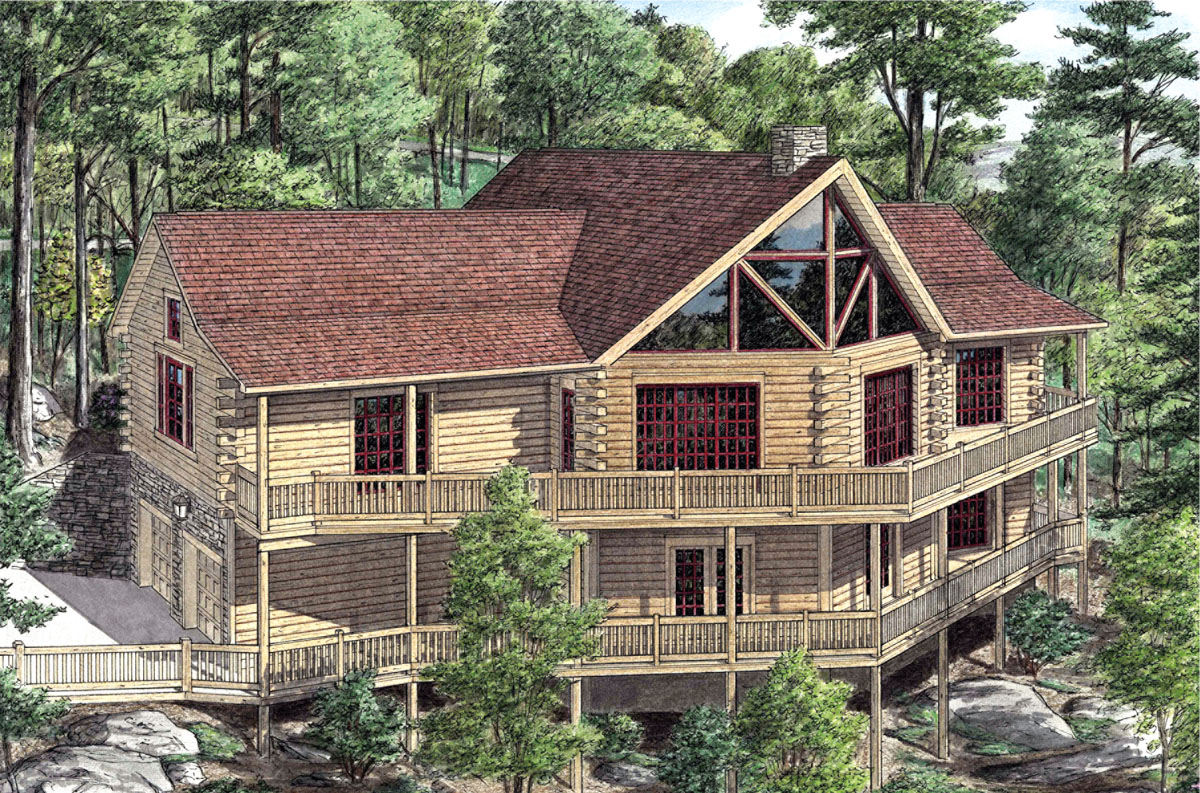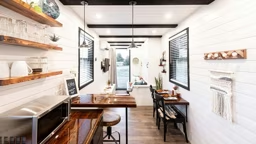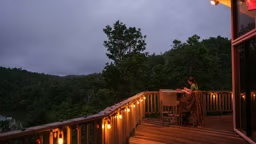
5 TIPS FOR CHOOSING A BUILDER
1. Once you have a pool of likely candidates, conduct interviews: Has anyone built a vacation home before? Similar to what you want? Who’s a good listener, and who has ideas to improve your project? Your builder should be familiar with the area, the climate and conditions, and local building codes and suppliers.
2. Ask about architects, suppliers and subcontractors the builder works with, and check with them.
3. Contact references and visit their cabins. Look for quality work – especially flooring, trim and windows. Ask them: Are you happy with your cabin? Was it completed on time and on budget? If you had any problems, were they fixed promptly and properly?
4. Ask candidates for their state and local license numbers.
5. Request to see original certificates of insurance before any work is done.
The Importance of Contract Once You Find a Builder
Contracts should:
- Be as detailed as possible, and reference blueprints and specifications. The blueprints should include floor plans, elevations, structural drawings, and construction details showing precisely how all the elements of the cabin, from floor to roof, are to be constructed. Specifications list all the materials that are to be used, and can be more than 20 written pages.
- Include applicable building codes and permit restrictions, plus associated fees for review and inspection.
- Clearly state price and how payments are made, typically after completion of each phase. You’ll want to withhold, say, 10% until your “punch list”* is satisfied.
- Specify how substitutions are to be handled if specified materials are not available, and how change orders will be priced. However, in rural areas it’s not uncommon for such issues to be resolved verbally. If that’s the case, make sure your builder tells you first what it will cost if he/she wants to do something different, so there are no misunderstandings.
What's the difference between a builder and a contractor?
You often hear the words “builder,” “contractor” and “general contractor” (GC) used interchangeably. A builder who signs a contract with you is a contractor. In cabin country, a builder is often a “general contractor” who manages and coordinates his/her own crew of carpenters, along with various tradesmen called “subcontractors.” These “subs” include excavators, masons, roofers, electricians, plumbers, HVAC pros, drywall installers, painters, landscapers and pavers.
What is the definition of punch list?
When your builder and crew are done, carefully inspect the cabin. Note anything that isn’t complete, or DONE
to your satisfaction. That’s referred to as a punch list.
How to Find and Work with a Builder: Case Study
Years ago, Gregg’s parents bought a place on Fish Lake in northwestern Wisconsin where Gregg and his siblings spent idyllic summers. The old cabin was built in the 1930s as part of a resort. “It had two little bedrooms with curtains for doors, and one great room,” recalls Gregg. “It was a modest, traditional cabin that became the center of family life.” The couple and their two sons stayed there often, always dreaming of building their own place.
About 10 years ago, the Larsons noticed a new cabin for sale nearby. They liked the design and considered buying it, but someone beat them to it. The couple learned that the builder, John Willard of Emerson Construction (based in Minneapolis, Minn.), had built others on the lake as well. His stick-built cabins were rustic and woodsy, with log accents.
Since there are a handful of builders in the area, the Larsons did their homework, comparing neighbors’ experiences with different contractors before coming back to Willard. “We liked the half-log siding, lots of windows, all-wood interior walls, wood flooring, and big, open great room,” says Jayne.
Not your ordinary home
Cabins are a breed apart from primary residences, so your builder should specialize in (or at least, have experience with) second homes.
The site plays a huge role in the design and layout of cabins, more so than with primary homes in urban settings. For example, does your lot slope? If so, how does this affect a walkout basement? Are there setback restrictions? Do you need a well and/or a septic system? “You have to work with the site as it is,” says Willard.
As for style, vacation homes tend to be smaller and more open than primary residences, with lots of glass for light and vistas. Transition spaces – decks, screen porches, patios, mudrooms – make a small cabin live large. Since you’re only there for weekends or vacations, make it as maintenance free as possible.
About 10 years ago, the Larsons noticed a new cabin for sale nearby. They liked the design and considered buying it, but someone beat them to it. The couple learned that the builder, John Willard of Emerson Construction (based in Minneapolis, Minn.), had built others on the lake as well. His stick-built cabins were rustic and woodsy, with log accents.
Since there are a handful of builders in the area, the Larsons did their homework, comparing neighbors’ experiences with different contractors before coming back to Willard. “We liked the half-log siding, lots of windows, all-wood interior walls, wood flooring, and big, open great room,” says Jayne.
Not your ordinary home
Cabins are a breed apart from primary residences, so your builder should specialize in (or at least, have experience with) second homes.
The site plays a huge role in the design and layout of cabins, more so than with primary homes in urban settings. For example, does your lot slope? If so, how does this affect a walkout basement? Are there setback restrictions? Do you need a well and/or a septic system? “You have to work with the site as it is,” says Willard.
As for style, vacation homes tend to be smaller and more open than primary residences, with lots of glass for light and vistas. Transition spaces – decks, screen porches, patios, mudrooms – make a small cabin live large. Since you’re only there for weekends or vacations, make it as maintenance free as possible.
Building a relationship
Let’s say you’ve lined up a builder who is knowledgeable about cabin construction, is competent, and seems to be compatible. Bravo! Since it can take a year or longer to build a cabin, builders often become like part of the family in the process. In fact, many cabin owners and builders remain friends, especially if they share common interests like fishing or skiing.
Obviously, it makes life easier if you develop a good rapport with your builder. But from the outset, establish that this is a professional relationship. How? Get it in writing. Before that first nail is hammered, a contract should describe all the work to be done and all the materials to be used, including size, color, brand and number. The more detailed and thorough the contract, the more likely your cabin will be completed on time and on budget.
During the planning phase, the Larsons worked closely with their builder, Willard, and the draftsman at their lumberyard. They adjusted one of Willard’s existing cabin plans to fit the Larsons’ needs and desires as well as the nuances of their specific building site. Since the Larsons’ property is on a peninsula, the group collaborated to tweak the design of the walkout basement level to take advantage of the views. They accomplished this by adding dramatic floor-to-ceiling windows.
Plus, the home plan was adjusted by adding two feet in both the entryway and kitchen/dining area. “Just these modifications gave us a lot more space,” says Jayne.
Let’s say you’ve lined up a builder who is knowledgeable about cabin construction, is competent, and seems to be compatible. Bravo! Since it can take a year or longer to build a cabin, builders often become like part of the family in the process. In fact, many cabin owners and builders remain friends, especially if they share common interests like fishing or skiing.
Obviously, it makes life easier if you develop a good rapport with your builder. But from the outset, establish that this is a professional relationship. How? Get it in writing. Before that first nail is hammered, a contract should describe all the work to be done and all the materials to be used, including size, color, brand and number. The more detailed and thorough the contract, the more likely your cabin will be completed on time and on budget.
During the planning phase, the Larsons worked closely with their builder, Willard, and the draftsman at their lumberyard. They adjusted one of Willard’s existing cabin plans to fit the Larsons’ needs and desires as well as the nuances of their specific building site. Since the Larsons’ property is on a peninsula, the group collaborated to tweak the design of the walkout basement level to take advantage of the views. They accomplished this by adding dramatic floor-to-ceiling windows.
Plus, the home plan was adjusted by adding two feet in both the entryway and kitchen/dining area. “Just these modifications gave us a lot more space,” says Jayne.
Monitor; don’t micromanage
If possible, monitor construction regularly, weekly if possible, to see that everything is being done according to the specifications.
If distance prohibits you from monitoring construction, consider hiring a professional home inspector to do this for you. Don’t hesitate to ask if you don’t understand what the builder and his crew are doing.
“We kept a close eye on the cabin building process because in building our primary residence (located in Minnesota’s Twin Cities), we found out that ‘things can happen,’ ” says Jayne. On one visit to the construction site of their city home, the Larsons discovered a kitchen window in the wrong place. The work crew was able to correct the error because Jayne and Gregg noticed it right away.
While it’s important to monitor, don’t micromanage. You hired this builder because he/she is a professional and you trust him/her.
Lynn Gastineau is president of Gastineau Log Homes, a Missouri-based company that ships log kits to customers across the country and works with builders who specialize in log construction. Gastineau shares this advice she’s learned from 25 years in the construction business: “Let go of preconceived ideas and accept that there are different ways to do the same thing.”
Communication is job #1
Good communication between owner and builder is crucial. Because the Larsons had built a home before, they came to their cabin project knowing that even though you think you’re communicating, there can be misunderstandings – especially when your message gets relayed from builder to crew.
“Communication is where 90% of issues happen,” agrees Gastineau. “The other thing is making sure the builder understands your expectations. A lot of builders are not good at explaining to customers what they’re doing.”
If you have an issue with the quality of anything a builder has done, deal with things as they come up. “A lot of people avoid confrontation, and then they blow up,” adds Gastineau.
It’s important for you and your significant other to present a unified front. During the course of building, there will be numerous occasions where the builder needs your input and decisions on aesthetic and practical matters. Decide beforehand which one of you – maybe the one who can stay calm under pressure – will be the main spokesperson.
Remember, in cabin country, life in general tends to proceed at a slower pace. That goes for building, as well. So if things don’t seem to be progressing fast enough, try to take it in stride. Leave the stress at home. Pretty soon, you’ll be relaxing on your cabin porch admiring the view. After the dust settles, the construction will just be a distant memory.
For floor plans and more photos of the two cabins featured in this story, use these links:
RESOURCES
If possible, monitor construction regularly, weekly if possible, to see that everything is being done according to the specifications.
If distance prohibits you from monitoring construction, consider hiring a professional home inspector to do this for you. Don’t hesitate to ask if you don’t understand what the builder and his crew are doing.
“We kept a close eye on the cabin building process because in building our primary residence (located in Minnesota’s Twin Cities), we found out that ‘things can happen,’ ” says Jayne. On one visit to the construction site of their city home, the Larsons discovered a kitchen window in the wrong place. The work crew was able to correct the error because Jayne and Gregg noticed it right away.
While it’s important to monitor, don’t micromanage. You hired this builder because he/she is a professional and you trust him/her.
Lynn Gastineau is president of Gastineau Log Homes, a Missouri-based company that ships log kits to customers across the country and works with builders who specialize in log construction. Gastineau shares this advice she’s learned from 25 years in the construction business: “Let go of preconceived ideas and accept that there are different ways to do the same thing.”
Communication is job #1
Good communication between owner and builder is crucial. Because the Larsons had built a home before, they came to their cabin project knowing that even though you think you’re communicating, there can be misunderstandings – especially when your message gets relayed from builder to crew.
“Communication is where 90% of issues happen,” agrees Gastineau. “The other thing is making sure the builder understands your expectations. A lot of builders are not good at explaining to customers what they’re doing.”
If you have an issue with the quality of anything a builder has done, deal with things as they come up. “A lot of people avoid confrontation, and then they blow up,” adds Gastineau.
It’s important for you and your significant other to present a unified front. During the course of building, there will be numerous occasions where the builder needs your input and decisions on aesthetic and practical matters. Decide beforehand which one of you – maybe the one who can stay calm under pressure – will be the main spokesperson.
Remember, in cabin country, life in general tends to proceed at a slower pace. That goes for building, as well. So if things don’t seem to be progressing fast enough, try to take it in stride. Leave the stress at home. Pretty soon, you’ll be relaxing on your cabin porch admiring the view. After the dust settles, the construction will just be a distant memory.
For floor plans and more photos of the two cabins featured in this story, use these links:
RESOURCES
- Emerson Construction, Minneapolis, Minn., (612) 963-1777
- Gastineau Log Homes, www.oakloghome.com
Ready to build your dream cabin? After years of searching, you’ve found the perfect site. And, you’ve decided on a floor plan with features that suit your lifestyle and your budget. Now, all you need is a builder to make the magic happen.
The right builder, that is. Reality check: Just as no two building sites are identical, builders are not equal when it comes to expertise and experience – or even people skills, for that matter. Ideally, you should give as much consideration to hiring a builder as when choosing a lot and layout. After all, you’re entrusting this individual with making your dream come true.
Who ya’ gonna call?
So, how do you go about finding the builder that’s right for your project? Well, there are several ways: Get referrals from family and friends, the designer or architect who drew your plans, or real estate brokers. Visit home shows, where you can meet builders and view portfolios. And browse magazines like Cabin Life.
Or, maybe a talented craftsman has recently built a cabin in your neck of the woods, and it’s just what you had in mind. This was the case for Gregg and Jayne Larson.
The right builder, that is. Reality check: Just as no two building sites are identical, builders are not equal when it comes to expertise and experience – or even people skills, for that matter. Ideally, you should give as much consideration to hiring a builder as when choosing a lot and layout. After all, you’re entrusting this individual with making your dream come true.
Who ya’ gonna call?
So, how do you go about finding the builder that’s right for your project? Well, there are several ways: Get referrals from family and friends, the designer or architect who drew your plans, or real estate brokers. Visit home shows, where you can meet builders and view portfolios. And browse magazines like Cabin Life.
Or, maybe a talented craftsman has recently built a cabin in your neck of the woods, and it’s just what you had in mind. This was the case for Gregg and Jayne Larson.












